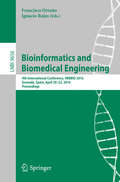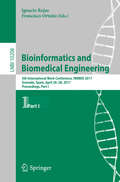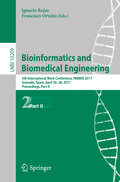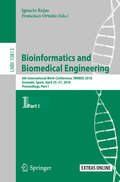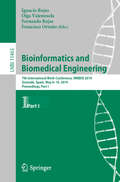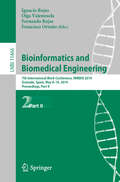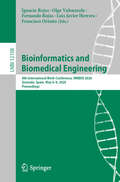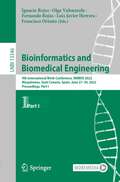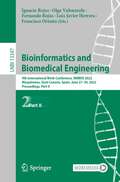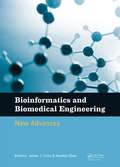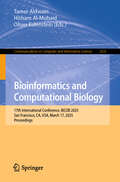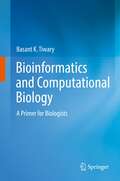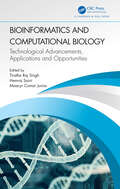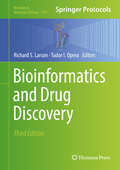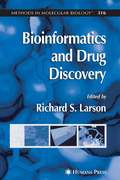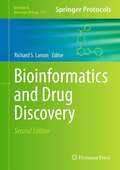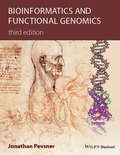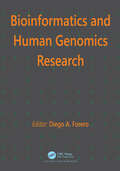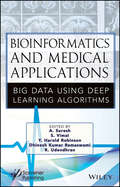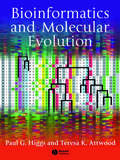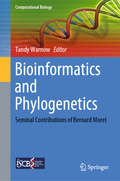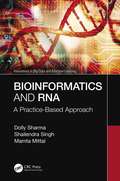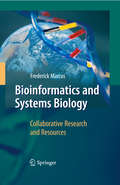- Table View
- List View
Bioinformatics and Biomedical Engineering: 4th International Conference, IWBBIO 2016, Granada, Spain, April 20-22, 2016, Proceedings (Lecture Notes in Computer Science #9656)
by Ignacio Rojas Francisco OrtuñoThis book constitutes the refereed proceedings of the 4th International Conference on Bioinformatics and Biomedical Engineering, IWBBIO 2016, held in Granada, Spain, in April 2016. The 69 papers presented were carefully reviewed and selected from 286 submissions. The scope of the conference spans the following areas: bioinformatics for healthcare and diseases; biomedical image analysis; biomedical signal analysis; computational systems for modeling biological processes; eHealth; tools for next generation sequencing data analysis; assistive technology for people with neuromotor disorders; fundamentals of biological dynamics and maximization of the information extraction from the experiments in the biological systems; high performance computing in bioinformatics, computational biology and computational chemistry; human behavior monitoring, analysis and understanding; pattern recognition and machine learning in the -omics sciences; and resources for bioinformatics.
Bioinformatics and Biomedical Engineering: 5th International Work-Conference, IWBBIO 2017, Granada, Spain, April 26–28, 2017, Proceedings, Part I (Lecture Notes in Computer Science #10208)
by Ignacio Rojas and Francisco OrtuñoThis two volume set LNBI 10208 and LNBI 10209 constitutes the proceedings of the 5th International Work-Conference on Bioinformatics and Biomedical Engineering, IWBBIO 2017, held in Granada, Spain, in April 2017. The 122 papers presented were carefully reviewed and selected from 309 submissions. The scope of the conference spans the following areas: advances in computational intelligence for critical care; bioinformatics for healthcare and diseases; biomedical engineering; biomedical image analysis; biomedical signal analysis; biomedicine; challenges representing large-scale biological data; computational genomics; computational proteomics; computational systems for modeling biological processes; data driven biology - new tools, techniques and resources; eHealth; high-throughput bioinformatic tools for genomics; oncological big data and new mathematical tools; smart sensor and sensor-network architectures; time lapse experiments and multivariate biostatistics.
Bioinformatics and Biomedical Engineering: 5th International Work-Conference, IWBBIO 2017, Granada, Spain, April 26–28, 2017, Proceedings, Part II (Lecture Notes in Computer Science #10209)
by Ignacio Rojas and Francisco OrtuñoThis two volume set LNBI 10208 and LNBI 10209 constitutes the proceedings of the 5th International Work-Conference on Bioinformatics and Biomedical Engineering, IWBBIO 2017, held in Granada, Spain, in April 2017. The 122 papers presented were carefully reviewed and selected from 309 submissions. The scope of the conference spans the following areas: advances in computational intelligence for critical care; bioinformatics for healthcare and diseases; biomedical engineering; biomedical image analysis; biomedical signal analysis; biomedicine; challenges representing large-scale biological data; computational genomics; computational proteomics; computational systems for modeling biological processes; data driven biology - new tools, techniques and resources; eHealth; high-throughput bioinformatic tools for genomics; oncological big data and new mathematical tools; smart sensor and sensor-network architectures; time lapse experiments and multivariate biostatistics.
Bioinformatics and Biomedical Engineering: 6th International Work-Conference, IWBBIO 2018, Granada, Spain, April 25–27, 2018, Proceedings, Part I (Lecture Notes in Computer Science #10813)
by Ignacio Rojas Francisco OrtuñoThis two-volume set LNBI 10813 and LNBI 10814 constitutes the proceedings of the 6th International Work-Conference on Bioinformatics and Biomedical Engineering, IWBBIO 2018, held in Granada, Spain, in April 2018.The 88 regular papers presented were carefully reviewed and selected from 273 submissions. The scope of the conference spans the following areas: bioinformatics for healthcare and diseases; bioinformatics tools to integrate omics dataset and address biological question; challenges and advances in measurement and self-parametrization of complex biological systems; computational genomics; computational proteomics; computational systems for modelling biological processes; drug delivery system design aided by mathematical modelling and experiments; generation, management and biological insights from big data; high-throughput bioinformatic tools for medical genomics; next generation sequencing and sequence analysis; interpretable models in biomedicine and bioinformatics; little-big data. Reducing the complexity and facing uncertainty of highly underdetermined phenotype prediction problems; biomedical engineering; biomedical image analysis; biomedical signal analysis; challenges in smart and wearable sensor design for mobile health; and healthcare and diseases.
Bioinformatics and Biomedical Engineering: 6th International Work-Conference, IWBBIO 2018, Granada, Spain, April 25–27, 2018, Proceedings, Part II (Lecture Notes in Computer Science #10814)
by Ignacio Rojas Francisco OrtuñoThis two volume set LNBI 10813 and LNBI 10814 constitutes the proceedings of the 6th International Work-Conference on Bioinformatics and Biomedical Engineering, IWBBIO 2018, held in Granada, Spain, in April 2018.The 88 regular papers presented were carefully reviewed and selected from 273 submissions. The scope of the conference spans the following areas: bioinformatics for healthcare and diseases; bioinformatics tools to integrate omics dataset and address biological question; challenges and advances in measurement and self-parametrization of complex biological systems; computational genomics; computational proteomics; computational systems for modelling biological processes; drug delivery system design aided by mathematical modelling and experiments; generation, management and biological insights from big data; high-throughput bioinformatic tools for medical genomics; next generation sequencing and sequence analysis; interpretable models in biomedicine and bioinformatics; little-big data. Reducing the complexity and facing uncertainty of highly underdetermined phenotype prediction problems; biomedical engineering; biomedical image analysis; biomedical signal analysis; challenges in smart and wearable sensor design for mobile health; and healthcare and diseases.
Bioinformatics and Biomedical Engineering: 7th International Work-Conference, IWBBIO 2019, Granada, Spain, May 8-10, 2019, Proceedings, Part I (Lecture Notes in Computer Science #11465)
by Ignacio Rojas Francisco Ortuño Olga Valenzuela Fernando RojasThe two-volume set LNBI 11465 and LNBI 11466 constitutes the proceedings of the 7th International Work-Conference on Bioinformatics and Biomedical Engineering, IWBBIO 2019, held in Granada, Spain, in May 2019. The total of 97 papers presented in the proceedings, was carefully reviewed and selected from 301 submissions. The papers are organized in topical sections as follows: Part I: High-throughput genomics: bioinformatics tools and medical applications; omics data acquisition, processing, and analysis; bioinformatics approaches for analyzing cancer sequencing data; next generation sequencing and sequence analysis; structural bioinformatics and function; telemedicine for smart homes and remote monitoring; clustering and analysis of biological sequences with optimization algorithms; and computational approaches for drug repurposing and personalized medicine. Part II: Bioinformatics for healthcare and diseases; computational genomics/proteomics; computational systems for modelling biological processes; biomedical engineering; biomedical image analysis; and biomedicine and e-health.
Bioinformatics and Biomedical Engineering: 7th International Work-Conference, IWBBIO 2019, Granada, Spain, May 8-10, 2019, Proceedings, Part II (Lecture Notes in Computer Science #11466)
by Ignacio Rojas Francisco Ortuño Olga Valenzuela Fernando RojasThe two-volume set LNBI 11465 and LNBI 11466 constitutes the proceedings of the 7th International Work-Conference on Bioinformatics and Biomedical Engineering, IWBBIO 2019, held in Granada, Spain, in May 2019. The total of 97 papers presented in the proceedings, was carefully reviewed and selected from 301 submissions. The papers are organized in topical sections as follows: Part I: High-throughput genomics: bioinformatics tools and medical applications; omics data acquisition, processing, and analysis; bioinformatics approaches for analyzing cancer sequencing data; next generation sequencing and sequence analysis; structural bioinformatics and function; telemedicine for smart homes and remote monitoring; clustering and analysis of biological sequences with optimization algorithms; and computational approaches for drug repurposing and personalized medicine. Part II: Bioinformatics for healthcare and diseases; computational genomics/proteomics; computational systems for modelling biological processes; biomedical engineering; biomedical image analysis; and biomedicine and e-health.
Bioinformatics and Biomedical Engineering: 8th International Work-Conference, IWBBIO 2020, Granada, Spain, May 6–8, 2020, Proceedings (Lecture Notes in Computer Science #12108)
by Ignacio Rojas Francisco Ortuño Olga Valenzuela Fernando Rojas Luis Javier HerreraThis volume constitutes the proceedings of the 8th International Work-Conference on IWBBIO 2020, held in Granada, Spain, in May 2020. The total of 73papers presented in the proceedings, was carefully reviewed and selected from 241 submissions. The papers are organized in topical sections as follows: Biomarker Identification; Biomedical Engineering; Biomedical Signal Analysis; Bio-Nanotechnology; Computational Approaches for Drug Design and Personalized Medicine; Computational Proteomics and Protein-Protein Interactions; Data Mining from UV/VIS/NIR Imaging and Spectrophotometry; E-Health Technology, Services and Applications; Evolving Towards Digital Twins in Healthcare (EDITH); High Performance in Bioinformatics; High-Throughput Genomics: Bioinformatic Tools and Medical Applications; Machine Learning in Bioinformatics; Medical Image Processing; Simulation and Visualization of Biological Systems.
Bioinformatics and Biomedical Engineering: 9th International Work-Conference, IWBBIO 2022, Maspalomas, Gran Canaria, Spain, June 27–30, 2022, Proceedings, Part I (Lecture Notes in Computer Science #13346)
by Ignacio Rojas Francisco Ortuño Olga Valenzuela Fernando Rojas Luis Javier HerreraThis volume constitutes the proceedings of the 9th International Work-Conference on IWBBIO 2020, held in Maspalomas, Gran Canaria, Spain, in June 2022. The total of 75 papers presented in the proceedings, was carefully reviewed and selected from 212 submissions. The papers cover the latest ideas and realizations in the foundations, theory, models, and applications for interdisciplinary and multidisciplinary research encompassing disciplines of computer science, mathematics, statistics, biology, bioinformatics, and biomedicine.
Bioinformatics and Biomedical Engineering: 9th International Work-Conference, IWBBIO 2022, Maspalomas, Gran Canaria, Spain, June 27–30, 2022, Proceedings, Part II (Lecture Notes in Computer Science #13347)
by Ignacio Rojas Francisco Ortuño Olga Valenzuela Fernando Rojas Luis Javier HerreraThis volume constitutes the proceedings of the 9th International Work-Conference on IWBBIO 2020, held in Maspalomas, Gran Canaria, Spain, in June 2022. The total of 75 papers presented in the proceedings, was carefully reviewed and selected from 212 submissions. The papers cover the latest ideas and realizations in the foundations, theory, models, and applications for interdisciplinary and multidisciplinary research encompassing disciplines of computer science, mathematics, statistics, biology, bioinformatics, and biomedicine.
Bioinformatics and Biomedical Engineering: Proceedings of the 9th International Conference on Bioinformatics and Biomedical Engineering (iCBBE 2015), Shanghai, China, 18-20 September 2015
by James J. Chou Huaibei ZhouThe 9th International Conference on Bioinformatics and Biomedical Engineering (iCBBE 2015) was held on September 18-20, 2015, Shanghai, China. This proceedings volume assembles papers from various professionals engaged in the fields of Biomedical Engineering, Bioinformatics and Computational Biology. The conference had special sessio
Bioinformatics and Computational Biology in Drug Discovery and Development
by William T. LogingComputational biology drives discovery through its use of high-throughput informatics approaches. This book provides a road map of the current drug development process and how computational biology approaches play a critical role across the entire drug discovery pipeline. Through the use of previously unpublished, real-life case studies the impact of a range of computational approaches are discussed at various phases of the pipeline. Additionally, a focus section provides innovative visualisation approaches, from both the drug discovery process as well as from other fields that utilise large datasets, recognising the increasing use of such technology. Serving the needs of early career and more experienced scientists, this up-to-date reference provides an essential introduction to the process and background of drug discovery, highlighting how computational researchers can contribute to that pipeline.
Bioinformatics and Computational Biology: 17th International Conference, BICOB 2025, San Francisco, CA, USA, March 17, 2025, Proceedings (Communications in Computer and Information Science #2535)
by Oliver Eulenstein Tamer Aldwairi Hisham Al-MubaidThis book constitutes the refereed proceedings of the 17th International Conference on Bioinformatics and Computational Biology, BICOB 2025, held in San Francisco, CA, USA, on March 17, 2025.The 18 full papers presented in this book were carefully reviewed and selected from 38 submissions.The papers cover a wide range of bioinformatics and computational biology topics, including bioinformatics algorithms, genomics, machine learning applications in bioinformatics, and medical informatics.
Bioinformatics and Computational Biology: A Primer for Biologists
by Basant K. TiwaryThis textbook introduces fundamental concepts of bioinformatics and computational biology to the students and researchers in biology, medicine, veterinary science, agriculture, and bioengineering . The respective chapters provide detailed information on biological databases, sequence alignment, molecular evolution, next-generation sequencing, systems biology, and statistical computing using R. The book also presents a case-based discussion on clinical, veterinary, agricultural bioinformatics, and computational bioengineering for application-based learning in the respective fields. Further, it offers readers guidance on reconstructing and analysing biological networks and highlights computational methods used in systems medicine and genome-wide association mapping of diseases. Given its scope, this textbook offers an essential introductory book on bioinformatics and computational biology for undergraduate and graduate students in the life sciences, botany, zoology, physiology, biotechnology, bioinformatics, and genomic science as well as systems biology, bioengineering and the agricultural, and veterinary sciences.
Bioinformatics and Computational Biology: Technological Advancements, Applications and Opportunities
by Hemraj Saini Tiratha Raj Singh Moacyr Comar JuniorBioinformatics and Computational Biology: Technological Advancements, Applications and Opportunities is an invaluable resource for general and applied researchers who analyze biological data that is generated, at an unprecedented rate, at the global level. After careful evaluation of the requirements for current trends in bioinformatics and computational biology, it is anticipated that the book will provide an insightful resource to the academic and scientific community. Through a myriad of computational resources, algorithms, and methods, it equips readers with the confidence to both analyze biological data and estimate predictions.The book offers comprehensive coverage of the most essential and emerging topics: Cloud-based monitoring of bioinformatics multivariate data with cloud platforms Machine learning and deep learning in bioinformatics Quantum machine learning for biological applications Integrating machine learning strategies with multiomics to augment prognosis in chronic diseases Biomedical engineering Next generation sequencing techniques and applications Computational systems biology and molecular evolution While other books may touch on some of the same issues and nuances of biological data analysis, they neglect to feature bioinformatics and computational biology exclusively, and as exhaustively. This book's abundance of several subtopics related to almost all of the regulatory activities of biomolecules from where real data is being generated brings an added dimension.
Bioinformatics and Drug Discovery (Methods in Molecular Biology #1939)
by Richard S. Larson Tudor I. OpreaThis third edition volume expands on the previous editions with new topics that cover drug discovery through translational bioinformatics, informatics, clinical research informatics, as well as clinical informatics. The chapters discuss new methods to study target identification, genome analysis, cheminformatics, protein analysis, and text mining. Written in the highly successful Methods in Molecular Biology series format, chapters include introductions to their respective topics, lists of the necessary materials, software workflows, reagents and on-line resources, together with step-by-step, readily reproducible laboratory and computational protocols, and tips on troubleshooting and avoiding known pitfalls.Cutting-edge and thorough, Bioinformatics and Drug Discovery, Third Edition is a valuable resource for anyone interested in drug design, including academicians (biologists, informaticists and data scientists, chemists, and biochemists), clinicians, and pharmaceutical scientists.
Bioinformatics and Drug Discovery (Methods in Molecular Biology #316)
by Richard S. LarsonA collection of readily reproducible bioinformatic methods to advance the drug discovery process from gene identification to protein modeling to the identification of specific drug candidates. The authors demonstrate these techniques, including microarray analysis, the analysis of genes as potential drug targets, virtual screening and in silico protein design, and cheminformatics, in a variety of practical situations. Because these technologies are still emergent, each chapter contains an extended introduction that explains the theory and application of the technology and techniques described.
Bioinformatics and Drug Discovery, 2nd Edition (Methods in Molecular Biology #910)
by Richard S. LarsonRecent advances in drug discovery have been rapid. The second edition of Bioinformatics and Drug Discovery has been completely updated to include topics that range from new technologies in target identification, genomic analysis, cheminformatics, protein analysis, and network or pathway analysis. Each chapter provides an extended introduction that describes the theory and application of the technology. In the second part of each chapter, detailed procedures related to the use of these technologies and software have been incorporated. Written in the highly successful Methods in Molecular Biology™ series format, the chapters include the kind of detailed description and implementation advice that is crucial for getting optimal results in the laboratory.<P><P> Thorough and intuitive, Bioinformatics and Drug Discovery, Second Edition seeks to aid scientists in the further study of the rapidly expanding field of drug discovery
Bioinformatics and Functional Genomics
by Jonathan PevsnerThe bestselling introduction to bioinformatics and functional genomics--now in an updated editionWidely received in its previous edition, Bioinformatics and Functional Genomics offers the most broad-based introduction to this explosive new discipline. Now in a thoroughly updated and expanded Second Edition, it continues to be the go-to source for students and professionals involved in biomedical research.This edition provides up-to-the-minute coverage of the fields of bioinformatics and genomics. Features new to this edition include:Several fundamentally important proteins, such as globins, histones, insulin, and albumins, are included to better show how to apply bioinformatics tools to basic biological questions.A completely updated companion web site, which will be updated as new information becomes available - visit www.wiley.com/go/pevsnerbioinformaticsDescriptions of genome sequencing projects spanning the tree of life.A stronger focus on how bioinformatics tools are used to understand human disease.The book is complemented by lavish illustrations and more than 500 figures and tables--fifty of which are entirely new to this edition. Each chapter includes a Problem Set, Pitfalls, Boxes explaining key techniques and mathematics/statistics principles, Summary, Recommended Reading, and a list of freely available software. Readers may visit a related Web page for supplemental information at www.wiley.com/go/pevsnerbioinformatics.Bioinformatics and Functional Genomics, Second Edition serves as an excellent single-source textbook for advanced undergraduate and beginning graduate-level courses in the biological sciences and computer sciences. It is also an indispensable resource for biologists in a broad variety of disciplines who use the tools of bioinformatics and genomics to study particular research problems; bioinformaticists and computer scientists who develop computer algorithms and databases; and medical researchers and clinicians who want to understand the genomic basis of viral, bacterial, parasitic, or other diseases.Praise for the first edition:"...ideal both for biologists who want to master the application of bioinformatics to real-world problems and for computer scientists who need to understand the biological questions that motivate algorithms." Quarterly Review of Biology"... an excellent textbook for graduate students and upper level undergraduate students." Annals of Biomedical Engineering"...highly recommended for academic and medical libraries, and for researchers as an introduction and reference..." E-Streams
Bioinformatics and Human Genomics Research
by Diego A. ForeroAdvances in high-throughput biological methods have led to the publication of a large number of genome-wide studies in human and animal models. In this context, recent tools from bioinformatics and computational biology have been fundamental for the analysis of these genomic studies. The book Bioinformatics and Human Genomics Research provides updated and comprehensive information about multiple approaches of the application of bioinformatic tools to research in human genomics. It covers strategies analysis of genome-wide association studies, genome-wideexpression studies and genome-wide DNA methylation, among other topics. It provides interesting strategies for data mining in human genomics, network analysis, prediction of binding sites for miRNAs and transcription factors, among other themes. Experts from all around the world in bioinformatics and human genomics have contributed chapters in this book. Readers will find this book as quite useful for their in silico explorations, which would contribute to a better and deeper understanding of multiple biological processes and of pathophysiology of many human diseases.
Bioinformatics and Medical Applications: Big Data Using Deep Learning Algorithms
by A. Suresh Y. Harold Robinson R. Udendhran S. Vimal Dhinesh Kumar RamaswamiBIOINFORMATICS AND MEDICAL APPLICATIONS The main topics addressed in this book are big data analytics problems in bioinformatics research such as microarray data analysis, sequence analysis, genomics-based analytics, disease network analysis, techniques for big data analytics, and health information technology. Bioinformatics and Medical Applications: Big Data Using Deep Learning Algorithms analyses massive biological datasets using computational approaches and the latest cutting-edge technologies to capture and interpret biological data. The book delivers various bioinformatics computational methods used to identify diseases at an early stage by assembling cutting-edge resources into a single collection designed to enlighten the reader on topics focusing on computer science, mathematics, and biology. In modern biology and medicine, bioinformatics is critical for data management. This book explains the bioinformatician’s important tools and examines how they are used to evaluate biological data and advance disease knowledge. The editors have curated a distinguished group of perceptive and concise chapters that presents the current state of medical treatments and systems and offers emerging solutions for a more personalized approach to healthcare. Applying deep learning techniques for data-driven solutions in health information allows automated analysis whose method can be more advantageous in supporting the problems arising from medical and health-related information. Audience The primary audience for the book includes specialists, researchers, postgraduates, designers, experts, and engineers, who are occupied with biometric research and security-related issues.
Bioinformatics and Molecular Evolution
by Teresa K. Attwood Paul G. HiggsIn the current era of complete genome sequencing, Bioinformatics and Molecular Evolution provides an up-to-date and comprehensive introduction to bioinformatics in the context of evolutionary biology. This accessible text: provides a thorough examination of sequence analysis, biological databases, pattern recognition, and applications to genomics, microarrays, and proteomics emphasizes the theoretical and statistical methods used in bioinformatics programs in a way that is accessible to biological science students places bioinformatics in the context of evolutionary biology, including population genetics, molecular evolution, molecular phylogenetics, and their applications features end-of-chapter problems and self-tests to help students synthesize the materials and apply their understanding is accompanied by a dedicated website - www.blackwellpublishing.com/higgs - containing downloadable sequences, links to web resources, answers to self-test questions, and all artwork in downloadable format (artwork also available to instructors on CD-ROM). This important textbook will equip readers with a thorough understanding of the quantitative methods used in the analysis of molecular evolution, and will be essential reading for advanced undergraduates, graduates, and researchers in molecular biology, genetics, genomics, computational biology, and bioinformatics courses.
Bioinformatics and Phylogenetics: Seminal Contributions of Bernard Moret (Computational Biology #29)
by Tandy WarnowThis volume presents a compelling collection of state-of-the-art work in algorithmic computational biology, honoring the legacy of Professor Bernard M.E. Moret in this field. Reflecting the wide-ranging influences of Prof. Moret’s research, the coverage encompasses such areas as phylogenetic tree and network estimation, genome rearrangements, cancer phylogeny, species trees, divide-and-conquer strategies, and integer linear programming. Each self-contained chapter provides an introduction to a cutting-edge problem of particular computational and mathematical interest.Topics and features: addresses the challenges in developing accurate and efficient software for the NP-hard maximum likelihood phylogeny estimation problem; describes the inference of species trees, covering strategies to scale phylogeny estimation methods to large datasets, and the construction of taxonomic supertrees; discusses the inference of ultrametric distances from additive distance matrices, and the inference of ancestral genomes under genome rearrangement events; reviews different techniques for inferring evolutionary histories in cancer, from the use of chromosomal rearrangements to tumor phylogenetics approaches; examines problems in phylogenetic networks, including questions relating to discrete mathematics, and issues of statistical estimation; highlights how evolution can provide a framework within which to understand comparative and functional genomics; provides an introduction to Integer Linear Programming and its use in computational biology, including its use for solving the Traveling Salesman Problem.Offering an invaluable source of insights for computer scientists, applied mathematicians, and statisticians, this illuminating volume will also prove useful for graduate courses on computational biology and bioinformatics.
Bioinformatics and RNA: A Practice-Based Approach (Innovations in Big Data and Machine Learning)
by Mamta Mittal Shailendra Singh Dolly SharmaThis book offers a unique balance between a basic introductory knowledge of bioinformatics and a detailed study of algorithmic techniques. Bioinformatics and RNA: A Practice-Based Approach is a complete guide on the fundamental concepts, applications, algorithms, protocols, new trends, challenges, and research results in the area of bioinformatics and RNA.The book offers a broad introduction to the explosively growing new discipline of bioinformatics. It covers theoretical topics along with computational algorithms. It explores RNA bioinformatics, which contribute to therapeutics and drug discovery. Implementation of algorithms in a DotNet Framework with code and complete insight on the state-of-the-art and recent advancements are presented in detail. The book targets both novice readers as well as practitioners in the field. FEATURES Offers a broad introduction to the explosively growing new discipline of bioinformatics Covers theoretical topics and computational algorithms Explores RNA bioinformatics to unleash the potential from therapeutics to drug discovery Discusses implementation of algorithms in DotNet Frameworks with code Presents insights into the state of the art and recent advancements in bioinformatics The book is useful to undergraduate students with engineering, science, mathematics, or biology backgrounds. Researchers will be equally interested.
Bioinformatics and Systems Biology: Collaborative Research and Resources
by Frederick MarcusCollaborative research in bioinformatics and systems biology is a key element of modern biology and health research. This book highlights and provides access to many of the methods, environments, results and resources involved, including integral laboratory data generation and experimentation and clinical activities. Collaborative projects embody a research paradigm that connects many of the top scientists, institutions, their resources and research worldwide, resulting in first-class contributions to bioinformatics and systems biology. Central themes include describing processes and results in collaborative research projects using computational biology and providing a guide for researchers to access them. The book is also a practical guide on how science is managed. It shows how collaborative researchers are putting results together in a way accessible to the entire biomedical community.
